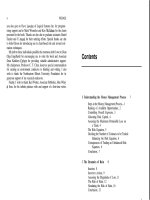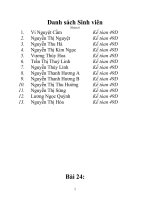Reading 25 credit strategies
Bạn đang xem bản rút gọn của tài liệu. Xem và tải ngay bản đầy đủ của tài liệu tại đây (75.2 KB, 4 trang )
Question #1 of 9
A credit investor has been conducting extensive research on incorporating ESG
considerations into his security selection in the technology sector. The investor has
created a custom benchmark consisting of corporate technology bonds and his goal is
to outperform the benchmark.
Which credit investment strategy is most appropriate for the credit investor to follow?
A) Top-down approach.
B) Bottom-up approach.
C) Multi-factor approach that focuses on predicting economic cycles.
Question #2 of 9
There are potential benefits for a corporate bond portfolio manager to include CDOs
in their portfolio except:
A) relative value opportunities.
B) diversification.
C) leverage opportunities.
Question #3 of 9
Laura Timura is the chief risk manager for Quanta Financial, a U.K. based consulting
firm that specializes in risk management strategies for fixed income investors. A large
endowment recently received a significant holding in a publicly traded gold mining
stock and has hired Quanta to help them hedge this position until they can sell the
shares in 5 years.
Quanta has recommended a hedging strategy to minimize tail risk that most likely
includes:
A) selling put options on gold futures contracts.
B) buying credit spread options on the bonds of gold miners they find least attractively
valued.
C) purchasing calls on gold futures.
Question #4 of 9
Global portfolio managers can often hedge emerging market currency risk by all of the
following, except:
A) selling currency futures.
B) swapping the foreign currency for domestic currency of the investor.
C) selling currency forwards.
Question #5 of 9
Sunil Ranieel is an investment-grade fixed income investment strategist for a large
pension fund based in the UK. Ranieel was at a recent luncheon and was describing
his investment process to some local college students at his lunch table. Ranieel's
investment process will primarily be focused on:
A) debt covenants.
B) collateral valuation.
C) interest rates.
Question #6 of 9
Derek Main is a recent college graduate and has been hired as a full-time junior
analyst for Falcon Financial, a firm that specializes in providing fixed income
investment advice to local pensions. Main has been assigned to analyze a newly
issued putable bond.
Main calculates various credit spread measures to begin his analysis.
The calculated spread measures are as follows:
G – Spread 322
I – Spread
325
Z – Spread 334
Main notices that he forgot to calculate an OAS measure, would the OAS be similar to,
lower than, or higher than the Z spread measure:
A) OAS would be similar to the Z spread.
B) OAS would be higher than the Z Spread.
C) OAS would be lower than the Z spread.
Question #7 of 9
Bid-ask spreads have historically been used to assess liquidity in fixed income
markets. However, this indicator has proven to be less reliable primarily because:
A) of reduced spread sensitivity to fund outflows.
B) of increased assets under management in Fixed-Income ETFs.
C) bond dealers and brokers generally hold much less inventory than in the past
because of regulatory and capital constraints.
Question #8 of 9
A bond portfolio manager using the bottom-up approach to security selection
would most likely begin their analysis by focusing on:
A) bonds that have comparable credit risk.
B) average credit spreads.
C) macro factors that drive interest rates.
Question #9 of 9
As a result of the continued global low interest since the financial crisis of 2008,
investors have been investing in larger amounts of emerging market corporate bonds
to find increased yields. However, investing in emerging market corporate bonds is
very different than investing in developed market corporate bonds.
The following statement correctly identifies these general differences:
A) Emerging market bonds have an increased concentration in commodities and
banking compared to developed market bonds.
B) Developed market bonds tend to have lower average credit quality compared to
emerging market bonds.
C) Since the most recent financial crisis, the developed bond market is overcontrated in
government issued bonds as compared to emerging market capital markets as
investors flee to safer bonds.









